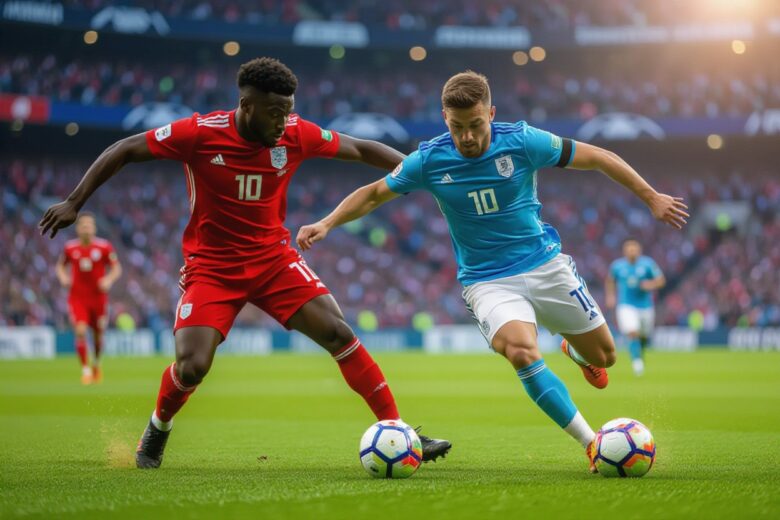Over the years, you have witnessed the right-back position transform dramatically, shifting from a purely defensive role to becoming a key attacking weapon on the field. As you follow the game’s tactical changes, you’ll see how modern right-backs now contribute not just by defending but by overlapping runs, delivering precise crosses, and even scoring goals. Understanding this evolution helps you appreciate the dynamic skills and versatility required of contemporary right-backs, highlighting their impact on both defense and offense in football strategies today.
The Traditional Role of the Right-Back: Guardian of the Flanks
As you analyze the classic right-back position, you’ll notice the primary focus remains on defending the flank with discipline. Traditionally, right-backs have been tasked with marking wingers tightly, preventing crosses, and supporting center-backs by maintaining a solid defensive line. Their role was less about attacking contribution and more about providing defensive stability and coverage for your backline.
Defensive Responsibilities and Tactics
You’ll find that right-backs have historically concentrated on containing opposition wingers, employing tactics like jockeying, tackling, and intercepting passes to limit attacking threats down their side. Positioning between the winger and the penalty area stays paramount, with many coaches emphasizing strict adherence to defensive shape and timing when engaging in challenges to avoid exposing your team.
The Evolution Through the Ages
Over decades, the role of the right-back transitioned from a purely defensive player to one who also supports offensive phases, beginning with players like Kenny Sansom in the 1980s and later highlighted by Cafu, whose relentless runs added a new dimension to the position. Tactical shifts and football philosophy changes have made the right-back a more dynamic and versatile role.
Diving deeper, you can observe that tactical innovations such as the rise of the 4-3-3 and 3-5-2 formations pressed right-backs to take on fuller roles, becoming auxiliary wingers or overlapping runners. This transformation demanded enhanced stamina, ball control, and crossing ability, moving beyond just defensive duties. Modern legends like Dani Alves further redefined this evolution by integrating creativity with defense, influencing countless players and tactical frameworks worldwide.
Tactical Revolution: The Rise of Positional Play
The shift towards positional play dramatically transformed the right-back role, emphasizing spatial awareness and fluid positioning over rigid defensive assignments. As teams began to prioritize ball retention and territorial control, right-backs started to exploit half-spaces and wide channels simultaneously. This evolution meant adapting to a dual responsibility: anchoring the defense while actively initiating offensive phases. Your nuanced understanding of space and timing becomes key, as right-backs increasingly function as both stabilizers at the back and creative outlets further up the pitch.
Impact of Total Football on Right-Back Duties
Total Football revolutionized the right-back position by promoting versatility and constant movement, requiring players to interchange roles seamlessly. Dutch legends like Ruud Krol redefined the position, stepping into midfield or attack during play. You witness how this system demanded heightened technical skill and tactical intelligence from right-backs, expanding their responsibilities from mere defenders to integral parts of offensive buildups, thus setting a precedent for the dynamic full-backs you see today.
The Influence of Modern Managers and Systems
Managers like Pep Guardiola and Jürgen Klopp have further elevated the right-back role within their distinct tactical frameworks. Guardiola’s approach transforms the right-back into an additional playmaker, often positioned centrally during build-up to overload midfield, while Klopp’s emphasis on high pressing and quick transitions pushes right-backs to act as aggressive outlets on counterattacks. These strategies significantly broaden your understanding of the position, highlighting adaptability and attacking impetus as defining characteristics of contemporary full-backs.
Digging deeper, Guardiola’s utilization of players like Dani Alves and João Cancelo exemplifies how right-backs can manipulate tight spaces, often drifting inside to support midfield creation and stretch defensive lines. Contrastingly, Klopp’s deployment of Trent Alexander-Arnold showcases how rapid, precise crossing and overlapping runs become critical offensive weapons. Both managers have instilled a mentality that demands right-backs to master not just defensive solidity but technical proficiency, vision, and relentless stamina, embedding the position firmly as an attacking threat in squad dynamics.
Skillset Expansion: From Marking to Playmaking
As the right-back role has evolved, your responsibilities extend far beyond traditional defensive marking. Modern right-backs are expected to seamlessly integrate into attacking phases, requiring a diverse set of skills. You must combine defensive solidity with creative instincts, mastering ball control, accurate crossing, and incisive passing to drive play forward. This transition demands both physical stamina and tactical intelligence, as you constantly switch between shielding your backline and initiating offensive moves.
The Necessity of Ball Skills and Passing Prowess
Handling the ball with confidence under pressure sets you apart as a right-back able to influence your team’s build-up play. Precision in short and long passing opens lanes and breaks opposition lines, amplifying your playmaking impact. Players like Trent Alexander-Arnold exemplify how elevated technique and vision can transform a defender into a primary creative outlet, delivering assists and dictating tempo from deep positions.
Transitioning to Attacking Roles: Key Attributes
Successfully shifting into an attacking right-back demands pace to outflank opponents, endurance to make continuous overlapping runs, and a keen sense for timing crosses into the box. You need a sharp tactical awareness, reading when to join attacks without leaving defensive gaps. The ability to combine with wingers and midfielders, through quick interplay and positional fluidity, enhances your threat, turning you into a multifaceted weapon on the flank.
Diving deeper, your attacking attributes must harmonize with your team’s style. Understanding spatial dynamics enables you to exploit half-spaces or wide areas effectively. Developing a strong left foot, along with your dominant right, can double your crossing angles and unpredictability. Additionally, mastering set-pieces and delivering pinpoint corners or free-kicks elevates your contribution, as seen in players like João Cancelo, whose multifaceted attacking skills inspire tactical versatility across modern defenses.
Notable Right-Backs Who Changed the Game
Tracking the trajectory of right-backs, you encounter names that have literally shaped the role over decades. Some revolutionized defensive solidity, while others expanded the positional blueprint to attack with vigor. Seeing their influence helps decode how the right-back evolved from a purely defensive player into a multifaceted threat.
Historical Figures: Pioneers of the Role
Dani Alves and Cafu might easily spring to mind, but your understanding deepens once you explore earlier figures like José Santamaría and Lilian Thuram, who laid down tactical foundations in the mid to late 20th century. These players showcased early signs of blending defensive responsibility with forward thrusts, setting templates later stars would electrify.
Contemporary Masters: Redefining the Position
Modern right-backs like Trent Alexander-Arnold, João Cancelo, and Achraf Hakimi are reshaping your expectations for what the position demands. With towering assist numbers and dynamic attacking runs, they become more akin to playmakers than simple defenders, underlining the tactical transformation this role continually undergoes.
Take Trent Alexander-Arnold’s 2021-2022 Premier League season, where he provided 7 assists, rivaling some midfielders, not just fellow defenders. João Cancelo’s fluid interchanges between right-back and winger roles at Manchester City demonstrate how versatility enhances your tactical options, making a traditionally defensive spot a hub for offensive creativity. Achraf Hakimi’s explosive pace and crossing ability for both club and country further emphasize this evolution, allowing you to utilize your right-back in roles that unsettle defenders consistently on multiple fronts.
The Future of the Right-Back: Trends and Predictions
Emerging tactics increasingly demand right-backs to be versatile athletes who balance robust defense with dynamic offensive contributions. You’ll notice a surge in full-backs acting as auxiliary midfielders, with clubs like Manchester City and Bayern Munich setting the pace. Physical conditioning, tactical intelligence, and technical skills will define the next generation, as the role morphs into a hybrid of defender, creator, and winger. Expect innovations in formation fluidity and specialized training aimed at maximizing the right-back’s impact across all phases of play.
Analyzing Data and Performance Metrics
Advanced analytics are transforming how you assess right-back effectiveness, combining traditional stats like tackles and interceptions with expected assists (xA), progressive carries, and measured contribution to build-up play. Clubs employ heatmaps and real-time GPS tracking to tailor strategies and improve positioning. For instance, metrics from Opta and StatsBomb reveal that top-performing right-backs average over 3 key passes and 2 successful progressive runs per 90 minutes, elevating their role from purely defensive to key offensive initiators.
The Role of Youth Academies and Development
Youth programs now integrate comprehensive training that fuses defensive solidity with creative freedom, preparing right-backs to thrive in multipurpose roles. Academies like Ajax and Barcelona emphasize technical mastery, tactical awareness, and positional versatility from early stages. You’ll find these systems producing players capable of contributing beyond the back line, nurturing instincts for overlapping runs and intelligent ball distribution, aligned perfectly with modern tactical demands.
Expanding on youth development, academies increasingly adopt position-specific curricula that balance the traditional defensive baseline with cultivating offensive mindset. Training modules focus on spatial awareness, decision-making under pressure, and coordinated wing play, ensuring that by the time youngsters reach senior squads, they adapt seamlessly to evolving systems. Examples include Sevilla’s emphasis on technical drills paired with small-sided games, fostering right-backs who anticipate attacking transitions effectively. This blended approach equips players with the aptitude to interchange roles dynamically, pushing the right-back function far beyond its prior constraints.
Final Words
Ultimately, the evolution of the right-back role highlights how modern football demands versatility and tactical intelligence from you as a player or enthusiast. No longer confined to defensive duties, you now see right-backs influencing the game offensively with pace, creativity, and precise crossing. Understanding this transformation can deepen your appreciation of team strategies and player development, showing how the position has grown into a dynamic force that contributes significantly to both defense and attack.




